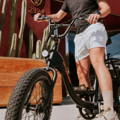What Are Fat Tire Electric Bikes and Who Are They For?
Written by: Rémy Rossi | July 27, 2025 | Time to read 5 min
Big tires, big fun. Fat tire e-Bikes offer stability, traction, and confidence on just about any terrain—no matter where your adventure takes you.

More about the Author: Remy Rossi
Rémy Rossi is a bike writer, mechanic, and educator who got his start in community-based bike shops and co-ops. With a decade in the industry, he still wrenches on bikes when he can and plays bike polo on a fixie.

What is a fat tire electric bike?

Fat tire electric bikes can be ridden confidently almost anywhere because of their wide tires and pedal assistance, which offsets any weight gains or extra rolling resistance from the tires. There are recreational all-terrain, moto-style, cargo e-Bikes, and folding models with fat tires.
Types of fat tire e-Bikes
Fat tire electric bikes all have wide tires, but they come in a few different flavors. Here are the most common categories of fat tire e-Bikes stocked by Upway:
- All‑Terrain Fat‑Tire e‑Bikes: Multi-surface bikes with wide 3–5″ tires, often front suspension, and sturdy frames—perfect for sand, mud, snow, pavement, or light trails.
- Moto‑Inspired Fat‑Tire e‑Bikes: Sporty, high-torque models with aggressive styling and static seats, built for riders seeking power and acceleration.
- Utility/Cargo Fat‑Tire e‑Bikes: Rugged bikes equipped for hauling, featuring cargo racks and heavy load capacity for groceries, gear, or passengers.
- Folding Fat‑Tire e‑Bikes: More compact than other fat bikes, the foldable frames allow for smaller storage and easy transport in the back of a car.
All-terrain e-Bikes vs. electric mountain bikes

E-MTBs, on the other hand, have fancier parts for more aggressive, performance-oriented riding. They have more premium parts like suspension forks, rear shocks, drivetrains, and hydraulic brakes that can really stand up to rowdy riding— and there’s significantly longer suspension than fat tire e-Bikes that typically max out at around 80mm to 100mm front suspension.
Do I need fat tires on an electric bike?

That said, those benefits come at the cost of weight savings and efficiency. Fat tires add a significant amount of weight, and the often heavy tire tread increases rolling resistance, meaning the electric bike motor has to work that much harder.
The biggest factor is that the weight is added to the wheel and rim area of the bike— weight here is equivalent to adding up to 10x more weight to the frame of the bike in terms of efficiency. Most fat tire e-Bikes have rear hub motors, and the motors will have to use more power to rotate the wheels with more mass, draining battery life. Riders also report that fat tire e-Bikes are very difficult to ride with no assistance if the battery dies, due to the weight and cumbersome tires.
In general, if you ride soft terrains like snow or sand, fat tires can provide some serious gains. Comfort-oriented riders will also enjoy the additional cushion from such high-volume tires— just keep in mind that these beefy bikes aren’t designed for ultimate efficiency. Here are the best fat tire e-Bikes for summer!
Who are fat tire electric bikes for?

- Comfort-oriented riders: Fat tires are even bigger than balloon tires, meaning ultimate cushion and stability for relaxed cruises. Ideal for beginner e-Bikers, seniors, and chill riders.
- All-terrain recreational riders: Riders who want a versatile, all-terrain setup but don’t require a high-performance e-MTB. Fat tires can roll over almost everything off- and on-road, but add weight and size that’s not ideal for more technical mountain biking.
- Cargo riders: Utility and cargo e-Bikes often have wide tires to increase stability on heavily loaded bikes. Easy to ride and easy to handle, haul away!
Frequently Asked Questions
How wide are fat tires?
What is the warranty on Upway bikes?
Upway offers a one-year limited warranty on all its e-Bikes that covers mechanical and electrical defects. We also provide guaranteed delivery and will compensate as warranted in the rare case of any shipping damage.
Do you need a license for an electric bike?
Key Takeaways
- Fat tires = maximum comfort and control: Wide, low-pressure tires absorb bumps and grip loose terrain like sand, snow, and gravel.
- There’s a fat tire e-Bike for every lifestyle: From folding frames to utility haulers, fat tire bikes suit comfort riders, commuters, and adventurers alike.
- Not built for speed or efficiency: These bikes trade lightness and range for grip and stability, making motor assistance essential on longer rides.


